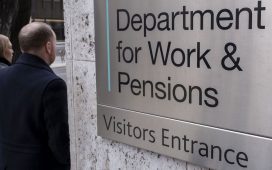Unlock the Editor’s Digest for free
Roula Khalaf, Editor of the FT, selects her favourite stories in this weekly newsletter.
Everyone in the UK will have their own stories of crumbling public services, but indulge me for a moment while I share mine. A couple of years ago, I applied for power of attorney on behalf of my ageing father, in case it became necessary. The Office of the Public Guardian bungled the paperwork; months later nothing had been done, but my father had died. I was told the fee would be refunded but, more than a year later, that hasn’t happened and the OPG is ignoring my emails.
Here’s another one. A year ago, we contacted the NHS’s Child and Adolescent Mental Health Service, CAMHS, for help with my teenage daughter. CAMHS sent over a stack of questionnaires for her, us and her school to fill out, which all of us duly did. For months, nothing happened. Nearly a year later, CAMHS sent us much the same stack of questionnaires and asked us to start again.
Or another. In May, my son was referred to an NHS orthodontist for treatment, but we heard nothing for months. When my wife popped in to ask whether any paperwork had gone missing, she was told that my son was in the system, but that they were still dealing with referrals from May 2020. The waiting list was more than three years long.
I don’t tell you these tales to gain sympathy. My daughter is fine, my son is fine and I don’t need that refund. And why would you sympathise? I fear that most British readers of this column will be channelling the “Four Yorkshiremen” sketch: “Oh, we used to dream of waiting for three years — it would have been an honour just to know we were on a waiting list” . . . “You were lucky to have your emails ignored. The OPG printed out our emails, soaked them in kerosene and used them to set fire to our house . . . ”
Anyway, one man’s anecdotes mean little enough. To find out whether the problem is real, we need to turn to the data. That data has been gathered in a joint effort by the Institute for Government (IFG) think-tank and the Chartered Institute of Public Finance and Accountancy (Cipfa). Each year they publish a public-services performance tracker, following the state of healthcare, social care, prisons, courts, schools and other services. Each year the story seems to get worse. This year the IFG has been using the less-than-encouraging phrase “doom loop”.
This doom loop encompasses most services you can think of. The crown court backlog has risen more than 50 per cent since March 2020, to about 65,000 cases — a number the IFG claims understates the true problem, since the backlog is now stuffed with more complex cases. The waiting list for elective hospital procedures has increased by almost 70 per cent since the start of the pandemic.
As for emergency cases, there was a longstanding target that fewer than 5 per cent of people would wait longer than four hours to be admitted, transferred or discharged after attending an A&E unit. Four hours is a long “emergency”, so this target never struck me as much of a stretch. Still, on the eve of the pandemic the four-hour benchmark was being missed in 25 per cent of cases. In 2022-23, nearly 45 per cent of cases were missing the four-hour target (unsurprisingly now abandoned). One of those cases was my father, shortly before he died.
The government points to the pandemic and the cluster of public-sector strikes to explain why things are going so badly, but the origins of this doom loop are much older. Take healthcare: according to the IFG, the UK has invested less than the average rich country on capital spending (medical scanners, hospital buildings and the like) and it’s done this almost every year since 1970. The two exceptions, both years under New Labour, can hardly compensate for half a century of scrimping. The austerity of the decade from 2010, during which healthcare investment was well below typical OECD levels, made matters worse, but it piled pressure on 40 years’ worth of weak foundations.
In the case of St Mary’s Hospital in London, these weak foundations are all too literal. The Financial Times recently reported that the hospital had rotting floor joists, frequent flooding, a hole in one lavatory floor that led to a car park, a ward closed due to a collapsed ceiling, and sewage backing up out of the drains and into the outpatient department. Yet St Mary’s is no longer regarded as an urgent priority for investment, because five other hospitals appear to be in more imminent danger of falling down.
Most public services deteriorated in the decade from 2010 under the pressure of austerity, and then deteriorated again during the pandemic. It is not easy to see how they will recover, since many years of weak economic growth have left the UK somehow achieving the trifecta of high taxes, chronic budget deficits and inadequate public services.
In case you’re still feeling optimistic, another think-tank, the Resolution Foundation, recently launched a report on infrastructure which pointed out that given the likelihood of more extreme weather, the challenges of decarbonising the energy system and the constrictions of Victorian sewers and railways, “a huge increase in investment” would be needed: “some household bills could double”. And I haven’t even mentioned potholes.
What can be done? The IFG argues for less churn in both personnel and policies, better industrial relations and more forward planning for recruiting new public-sector workers and retaining experienced staff — all reasonable ideas, but not the first time they have been raised.
Money is clearly also needed — not an emergency splurge, but a stable and sustained plan for investment over decades. It’s hard to see where that money will come from. The next government — almost certainly with Keir Starmer as prime minister — will start from an unenviable position. Yet they will have one advantage: everyone can see that something must change.
Tim Harford’s new book for children, ‘The Truth Detective’ (Wren & Rook), is now available
Follow @FTMag to find out about our latest stories first











